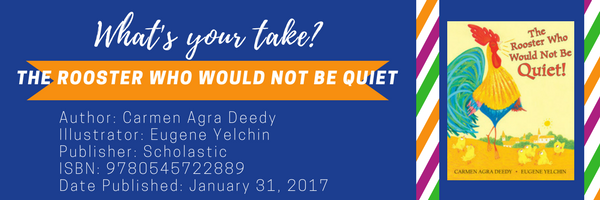 The recent presidential election in the U.S. brought forth many strong feelings and various reactions. As early childhood teacher educators, elementary teachers and mothers of young children, we are interested in exploring a set of books that highlight multiple forms of protest and the power of voice for some of our younger readers. Dorea Kleker and Lauren Pangle begin with their take on The Rooster Who Would Not Be Quiet! by Carmen Agra Deedy and illustrated by Eugene Yelchin.
The recent presidential election in the U.S. brought forth many strong feelings and various reactions. As early childhood teacher educators, elementary teachers and mothers of young children, we are interested in exploring a set of books that highlight multiple forms of protest and the power of voice for some of our younger readers. Dorea Kleker and Lauren Pangle begin with their take on The Rooster Who Would Not Be Quiet! by Carmen Agra Deedy and illustrated by Eugene Yelchin.

DOREA: The Rooster Who Would Not Be Quiet! was recommended to me by a mentor as I began to think about how to explore the various reactions to the recent U.S. election with students (both university and elementary). This story is set in a small noisy town in Cuba, where a newly-elected Mayor (running on a platform promising peace and quiet) quickly forbids not just singing loudly but noise of any kind. While some townspeople choose to leave under such mandates and others “learn to hum.” The majority choose to stay and quickly seem to forget life had ever been different. When Rooster arrives in town, he can’t help but do what roosters do–sing “Kee-kee-ree-kee!/¡Quiquiriquí” at the top of his lungs–and refuses to be silenced despite the Mayor’s many cruel attempts to do so.
What first strikes me about this book is just how many different roles are being played out. This isn’t a simple story about speaking out against power, but rather one that illuminates the complex dynamics that allow for a culture of oppression and the struggle to be heard despite this. In fact, there are so many dimensions to this book, I have a hard time knowing where to start.
I’ll begin with the page that catches my attention as I first read the book. The newly-elected Mayor, who wins by a landslide, begins making laws. What starts with the polite law of “NO LOUD SINGING IN PUBLIC, POR FAVOR,” is quickly followed by:
NO LOUD SINGING AT HOME.
NO LOUD SINGINGAT HOME
NOLOUDSINGINGAT HOME
¡BASTA! QUIET, ALREADY!
In a time when it seems that many of the freedoms we take for granted are being questioned or threatened, the visual representation of the text being slightly altered over time illuminates the ways that such drastic changes are not always made secretly, behind closed doors, but often visibly, in small ways, over time.
Lauren, I wonder if this page also caught your attention and whether there are any other places in the book in which the text and the illustration work together to create a stronger meaning for you?
LAUREN: Wow, Dorea, I agree; this is certainly not a simple story, but a timely reminder of the power of our voices.
I am also struck by the page showing how the “polite” law stating “NO LOUD SINGING IN PUBLIC, POR FAVOR” is quickly altered to an oppressive one. You asked if there are places where the text and illustration work together to create a stronger meaning for me, and the page adjacent to the NO SINGING laws certainly did. The illustration shows Mayor Don Pepe standing by a gravestone, holding a large book of LAWS and a leash worn by his muzzled, tail-tucked, slouched, unhappy dog. It is not so much the dog and tombstone that catch my attention, but it is the shapes and lines used to illustrate the Mayor. He has a sunken face, tired eyes and noticeable frown. His sharp, angular features are in stark contrast to the rounded features of most of the other townspeople, that difference stands out to me. The illustrator’s choice to create the Mayor’s physique in this way complements his oppressive style of leadership.
As I keep reading, I am struck by the text:
Some people left the village–singing loudly.
Others stayed behind and learned to hum.
The rest were just grateful to have a good night’s sleep, for crying out loud.
I first thought, if I were one of the townspeople in this book, which would I choose? Would I take my song somewhere else? Would I stay and learn to quiet my song to a hum? Or would I too be quiet and grateful for silence?
If I had to choose, it would be to stay behind and learn to hum because I would not be running away from the problem and I would not be accepting defeat–I would still have my song, albeit it quiet. But all of those choices allow the oppression to continue–they only benefit the person making the choice to leave, hum or be silent. None of those options help the greater good.
That is why I am thankful for the Rooster. The Rooster never gives up his song. His song does change in response to his situation, but he never leaves, he never quiets to a hum, and he is never silenced. It is his song that is always heard, no matter the change of tune.
Then I think about this in the context of our current political climate. I am grateful for the “roosters” in our communities, those who not only refuse to quiet their song, but those who encourage others to sing theirs.
Let our songs be heard.
DOREA: Carmen Agra Deedy speaks about this book on the podcast Scholastic Speaks. Interestingly, she also mentions a place in the book during which the pairing of text and illustration work together to create a powerful message. She takes us to the part of the story in which the Mayor has just covered Rooster’s cage with a blanket–after already have taken him from his family, isolated him and denied him food. On this page, the background is entirely dark and foreboding, with only the text of Rooster’s song boldly splashed in red across the page. Carmen speaks to the importance of this page stating, “There is no one in this world as courageous, as brave, as she or he who sings alone in the dark.”
Perhaps, what most captivates me about this book are the many entry points it provides for thoughtful and critical discussion and the ways we can’t help but consider ourselves in the context of this town. Just as you explore your quandary above, each page pushes me to question what my own actions and reactions would be. In addition to the question you ask yourself (which I also contemplate), I find myself pondering: What role have I played in allowing something unjust to continue? How do I stay vigilant so that something so outrageous ceases to feel “normal?” What is the breaking point for each of us? What do we each need to feel supported in singing our song and being heard? Could I sing alone in the dark? I look forward to using this book with our students–young and old–to hear the questions they wrestle with and the songs they can’t help but sing in response.
Title: The Rooster Who Would Not Be Quiet
Author: Carmen Agra Deedy
Illustrator: Eugene Yelchin
Publisher: Scholastic
ISBN: 9780545722889
Date Published: January 31, 2017
This is the first installment of June’s My Take/Your Take. To follow the whole conversation, check the WOW Blog every Wednesday.
- Themes: Carmen Agra Deedy, Dorea Kleker, Eugene Yelchin, Lauren Pangle, Rooster Who Would Not Be Quiet
- Descriptors: Books & Resources, My Take/Your Take
